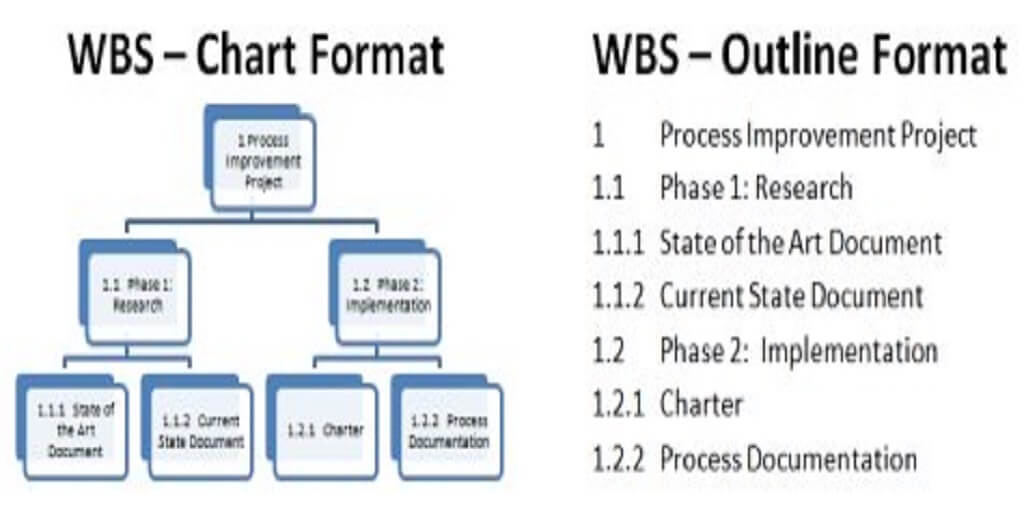Work breakdown structure or WBS is one of the most powerful methods for managing tasks in the project management.
WBS is traditionally associated with Waterfall project management methodology, but it is also a viable tool for Agile and Hybrid project management methods too.
Work Breakdown structure has been used successfully in large projects in such diverse industries as aerospace, constructions, manufacturing, software development and many others.
WBS refers to the method for breaking down high-level tasks into smaller tasks in a project to make them better understood and more manageable.
The high-level tasks are called level 1 tasks. Level one tasks are refined and are broken down into smaller tasks called subtasks.
These new tasks are called level 2 subtasks. Level 2 tasks are also refined further and broken down into level 3 subtasks.
This process will continue until we reach a level where a subtask can’t be broken down any further.
Level 1 tasks are commonly called tasks or container tasks, and level 2 tasks, level 3 tasks and so on are called subtasks.
The idea behind WBS is to continue breaking down tasks until they are small enough so that their implementation is totally understood and could be estimated with a high degree of certainty.
This is called top-down approach to task management and its benefits are well documented in numerous research papers. For references on WBS please check here.
Work Breakdown Structure benefits:
Here we have listed major benefits of Work breakdown structure. The reader is encouraged to refer to the vast literature available online on this subject for further reading.
- It reduces the possibility that important tasks are omitted in the project plan. The plan could be reviewed easily by others
- Helps to define project scope better than any other tool used in task management. In fact, there is no other tool that defines project scope the way WBS does.
- Makes all tasks in the project small and better understood. It helps to figure out to estimate each task better than any other task management process known today. It improves the accuracy of the project plan and schedule.
- It helps to estimate project cost much more accurately due to the fact all components of the project are well understood.
- It helps to better understand milestones and which tasks need to be finished before the milestone is reached.
- It reduces the confusion and misunderstanding about tasks and project scope and details. It clarifies project’s uncertainties and ambiguities.
- It helps to better track and monitor project and tasks progress during project life cycle
- Identifies assumptions both correct and wring in the project.
- It helps to identify important problems at an early stage in the project’s lifecycle.
- It identifies risks in the project by pointing to tasks which are difficult or not well understood. During implementation, if a task fall behind its effects on other tasks and the whole project outcome are instantly known.
- It makes the critical path in the project more accurate by making task estimation more accurate. The project manager using the critical path can better manage the project resources to make sure the task on critical path stays on schedule.
- It makes collaborating on projects easier since all tasks and their relations to each other are well known and understood.
- It makes team members more confident since the details of the project and their own work is well understood by them and by the management.
- It makes it easier to outsource portions of the project to outside companies or independent contractors since the details of each component of the project are well understood
- It enforces accountability in the project. Since all details are established and known by the team, it makes it easier to hold people accountable.
- It helps to accurately budget a project for resources and time.
Binfire is one of few task management applications on the market today which supports Work breakdown structure to sixth level (the maximum recommended by PMI).
Using Work breakdown structure, you can break down a large task into its smallest components, estimate the duration for each subtask and use dependencies to make the tasks interrelated.
When you set task duration for subtasks, the application automatically calculates the duration of the level one tasks containing all subtasks in them.
This greatly simplifies managing tasks and subtasks and frees the user from calculating the total time it takes the tasks which have subtasks.
For each task, you can set the start, duration, and due time. The application calculates the due date based on start date and duration.
Notice, the due time, is the time you want a task to finish on the due date. For example, you want a task to finish on March first at 8:00 PM.
Many industries rely on due time. Freelancer, contractors, and language translation companies come to mind.
A work not only needs to finish on a given date but also to a certain time in that day. Otherwise, it will be flagged as late.
Assume you your project is to translate a document and bring it to court on March 2nd at 8:00 Am. If you finish by 10:00 Am the document is worthless.
One of the most important benefits of WBS is that is makes tracking and monitoring of tasks much easier because each task’s duration is relatively short.
If a task falls behind, its effects on the rest of the system are shown immediately.
A great companion to WBS is the Gantt Chart since it shows all tasks and subtasks in a diagram arranged in time.
One of the hardest things to do in task management is the process of estimating tasks duration with a high degree of accuracy.
We highly recommend using three-point task estimation. This process helps to deliver the most accurate task estimation known in project management.
Another benefit of work breakdown structure is that is works perfectly with Gantt chart.
It creates a waterfall arrangement for tasks in time which makes the Gantt much more organized and easier to follow visually.
Give Binfire a try! It will help you manage tasks and projects better and be as productive as you can be!




Pingback: 10 Marketing Lessons You Can Learn From Miley Cyrus’s Twerking Performance at the VMAs | News By The Numbers
Pingback: 10 Marketing Lessons You Can Learn From Miley Cyrus’s Twerking Performance at the VMAs | News By The Numbers
Pingback: 10 Marketing Lessons You Can Learn From Miley Cyrus’s Twerking Performance at the VMAs | News By The Numbers
Pingback: 10 Marketing Lessons You Can Learn From Miley Cyrus’s Twerking Performance at the VMAs | News By The Numbers
Pingback: 10 Marketing Lessons You Can Learn From Miley Cyrus’s Twerking Performance at the VMAs | News By The Numbers
Pingback: Hybrid project management methodology - A startup case study - Collaboration Corner
Pingback: Hybrid project management methodology - A startup case study - Collaboration Corner
Pingback: Hybrid project management methodology - A startup case study - Collaboration Corner
Pingback: Hybrid project management methodology - A startup case study - Collaboration Corner
Pingback: Hybrid project management methodology - A startup case study - Collaboration Corner
Pingback: How to manage tasks at work - Collaboration Corner
Pingback: How to manage tasks at work - Collaboration Corner
Pingback: How to manage tasks at work - Collaboration Corner
Pingback: How to manage tasks at work - Collaboration Corner
Pingback: How to manage tasks at work - Collaboration Corner
Pingback: Introduction to Hybrid project management methodology - Collaboration Corner
Pingback: Introduction to Hybrid project management methodology - Collaboration Corner
Pingback: Introduction to Hybrid project management methodology - Collaboration Corner
Pingback: Introduction to Hybrid project management methodology - Collaboration Corner
Pingback: Introduction to Hybrid project management methodology - Collaboration Corner
Pingback: Myths about project management tools
Pingback: Myths about project management tools
Pingback: Myths about project management tools
Pingback: Myths about project management tools
Pingback: Myths about project management tools
Pingback: Project Planning- A complete tutorial - Collaboration Corner
Pingback: Project Planning- A complete tutorial - Collaboration Corner
Pingback: Project Planning- A complete tutorial - Collaboration Corner
Pingback: Project Planning- A complete tutorial - Collaboration Corner
Pingback: Project Planning- A complete tutorial - Collaboration Corner
Pingback: 25 mistakes project managers make - Collaboration Corner
Pingback: 25 mistakes project managers make - Collaboration Corner
Pingback: 25 mistakes project managers make - Collaboration Corner
Pingback: 25 mistakes project managers make - Collaboration Corner
Pingback: 25 mistakes project managers make - Collaboration Corner
Pingback: Can I use Work Breakdown Structure in Agile Project? - Collaboration Corner
Pingback: Can I use Work Breakdown Structure in Agile Project? - Collaboration Corner
Pingback: Can I use Work Breakdown Structure in Agile Project? - Collaboration Corner
Pingback: Can I use Work Breakdown Structure in Agile Project? - Collaboration Corner
Pingback: Can I use Work Breakdown Structure in Agile Project? - Collaboration Corner